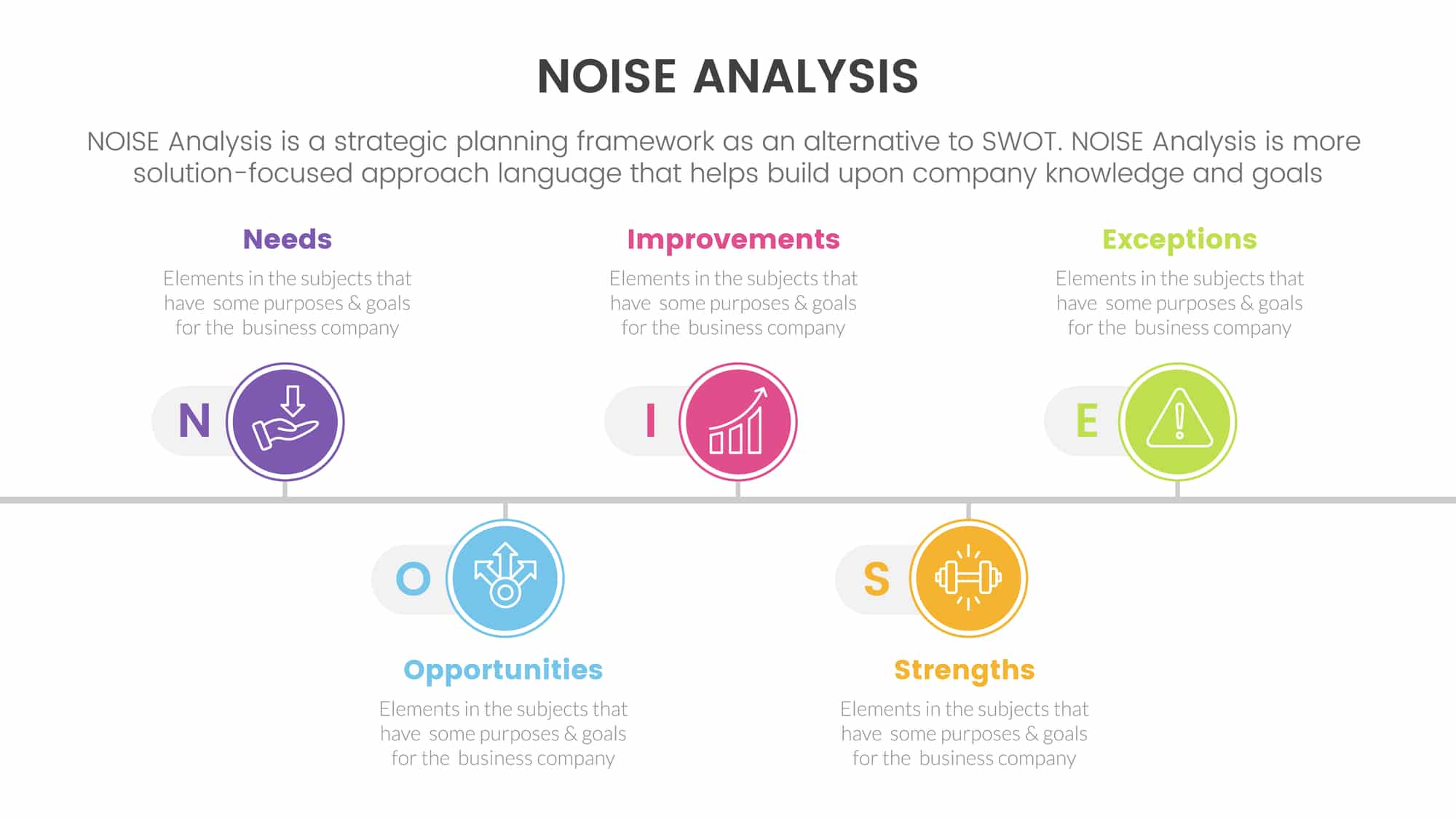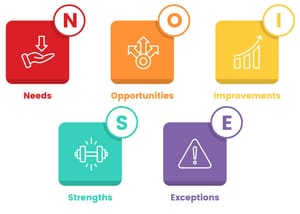What is NOISE analysis, and what are its benefits and limitations?? We show how to carry out one using a NOISE analysis template based on a real-life example.
For any organization to run smoothly and succeed within its respective industry it must carry out its strategic planning processes effectively. There are a number of strategic planning tools that help in this endeavor, and one such is the NOISE analysis. This article is aimed at explaining what a NOISE analysis is and how it can be used.
Before we proceed to discuss what a NOISE analysis is, it may help to get an idea of the strategic planning process, which consists of a number of steps on which different tools and techniques can be applied. The five main steps of this process are visioning, choosing goals, adding milestones, circumstance analysis, and revision.
There are a number of tools and techniques that can help in every stage of the strategic planning process. Such tools include SWOT analysis, PEST analysis, SOAR analysis, scenario planning, and competitor analysis.
Another valuable strategic planning tool that will be discussed here is NOISE analysis.

What is NOISE analysis?
The term NOISE analysis is an acronym consisting of five components: needs, opportunities, improvements, strengths, and exceptions. A NOISE analysis is yet another strategic planning tool that, at times, may serve as a good alternative to the basic SWOT analysis.
One of the reasons for this being a suitable alternative to SWOT analysis is that a NOISE analysis is not simply focused on providing an analysis of the situation, but it also focuses on the potential solutions. In addition, unlike its counterpart, which follows a top-down approach, a NOISE analysis is more collaborative and allows teams to work together.
It allows an organization to analyze its current situation and formulate a strategic plan to improve that particular situation. It is a solution-focused analysis tool that allows teams to utilize their existing knowledge to achieve goals and solve problems.
The way that this analysis works may help organizations realize opportunities that they were not aware of earlier.
Moreover, due to the fact that NOISE analysis helps teams focus on the past to improve the future of a business, it is suitable for both large organizations and smaller businesses. Furthermore, NOISE analysis is well suited to complement other strategic planning tools.
How To Carry Out A NOISE Analysis?
Carrying out a NOISE analysis involves following a seven-step process: deciding on a goal, creating a noise chart, beginning the analysis, identifying clusters, and voting on cluster categories. This is followed by creating measurements and milestones and, finally, the plan document.
Deciding On Goals
The first step of a NOISE analysis involves deciding on a goal that the organization wants to achieve. A suggested way of doing this would be to form a group of around five to twenty individuals who can share their insights on the matter.
The group can decide on matters such as where they would like to see the organization in a year and how the departments will perform to get the organization there. Furthermore, they can discuss if a system will hold departments and individuals accountable for their behavior during that time.
Another helpful approach could be to share a set of questions with all members of the group before they get together in person and ask them to come up with responses to those questions. Those questions include asking what the individual thinks is working fine and does not need to be altered.
Moreover, they can be asked how they will measure the change in the existing situation or their role in bringing about a positive change.
Creating A NOISE Chart
The actual creation of a NOISE chart can be as simple as drawing on a large piece of paper. For instance, members can start by drawing a circle in the middle of the paper with four quadrants extending out from that circle.
Beginning the Analysis
Beginning the NOISE analysis can involve a brainstorming session that discusses each of the five letters of the acronym, with the first four components comprising each quadrant (needs, opportunities, improvements, strengths) and exceptions being placed within the circle.
The first component, i.e., needs, represents what is required for the strategy to work, and these needs can be individual or organizational. Opportunities are external factors that can allow an organization to grow further. Opportunities can emerge in the form of untapped areas that can be worked on.
Improvements refer to the ways in which a company can evolve or change in order to establish needs and avail opportunities. Moreover, strengths are internal factors, which refer to what an organization is already good at.
Lastly, exceptions include any part of the first four components that is already happening, regardless of if the occurrence is at a large scale or just the bare minimum.
When coming up with responses for each of the components, it is best to start with strengths and then answer for needs, opportunities, improvements, and exceptions. This can be done individually, with each person sharing their views once they have written them down.
It is also important to note that this stage of the process involves coming up with as many ideas as possible; these can be filtered out later.
Identifying Clusters
The next logical step is to organize the generated information into clusters, where one cluster comprises similar ideas from each quadrant. This will also lead to the emergence of ideas that do not fit into any cluster. Such ideas can serve as a breakthrough for the company leading to its success.
These clusters can be named based on their theme, and then we can place the names in the NOISE chart within the right quadrant.
Voting On Cluster Categories
Once the cluster categories have been decided, the team can vote on and decide on the most relevant ones. They can use a dot voting system to do this.
Creating Measurement and Milestones
Measuring progress is integral for any process and is also true for carrying out a NOISE analysis. The team can come up with milestones and measures that are relevant for and needed to gauge the progress for each category.
Creating the Plan Document
This step involves the compilation of the decided categories into a broad company plan, and this is usually done either by the mediator or the team leader.
Not only is it important for each team member to approve the plan before implementation, but it is also essential to take feedback from them and make changes accordingly.
Furthermore, it is important to routinely review the document to ensure that it is updated and relevant according to the company’s needs.

Benefits And Limitations Of A NOISE analysis
As is the case with any strategic planning tool, a NOISE analysis also comes with its pros and cons. It is essential to get an idea of these before choosing to utilize this particular tool.
One obvious benefit of a NOISE analysis is that it positively frames problems. The problem seems like a future issue and is presented as something a company does not possess at the moment rather than something it needs. This positive framing motivates employees to do better rather than worry about what is lacking.
The solution-focused language used in the NOISE analysis allows team members to use their knowledge in order to solve problems.
Another benefit offered by the NOISE analysis, which is rather unique in itself, is the exception quadrant. This encourages a collaborative effort within the team and looks at what is already happening in the other quadrants, no matter how minor the change.
This quadrant makes people realize that something positive is already happening as a result of the team’s previous efforts, and those efforts can be built upon to escalate the progress.
Moreover, this analysis can help organizations to understand how complex the work is and in what order they should proceed.
NOISE Analysis Template
The basic NOISE template is in the form of a matrix, much like a SWOT analysis. However, unlike a SWOT Matrix, a NOISE analysis matrix includes an additional section or circle to accommodate exceptions.
The matrix comprises four quadrants, one for each of the first four letters of the acronym, including needs, opportunities, improvements, strengths, and an additional circle representing exceptions in the center of the matrix.
Needs
This component focuses on what a business requires and does not currently possess to achieve its goals. Needs are internal factors for the organization that it can control to a certain extent.
This component includes processes, people, resources, and materials. They can also refer to both organizational needs as well as individual needs.
Opportunities
The second component refers to the opportunities an organization can avail to succeed even further. These are external factors that the company cannot necessarily control but can take advantage of by playing to its strengths.
Opportunities can emerge over time or even already exist in the form of an untapped area of the market. Opportunities can also be available in the form of resources that have not been adequately utilized.
Improvements
This component can be internal or external; it represents the changes that need to be made as soon as possible to cover the organization’s needs.
Strengths
Strengths are internal factors for an organization that it already possesses and can control. Companies can play to their strengths in order to achieve their goals and progress further.
Exception
The exceptions component is unique and focuses on what is already happening within the other four quadrants, no matter at whichever scale. This allows organizations to identify what is going well and what is not.
NOISE Analysis Example
Let’s take the example of Levis for our NOISE analysis, where Levis wants to increase its online sales. One of the world’s most famous fashion brands known for its signature jeans, Levis is a well-known name.
The company can play to its strengths by utilizing its strong global presence, brand name, and well-established supply chain to acquire and serve those newly acquired customers around the world.
After a brainstorming session, the brand realizes that it needs to use data analytics to understand and serve its customers better. The explosive growth of online platforms has presented the opportunity to earn from online sales during the Covid-19 pandemic.
The brand can also make improvements to its current online marketing strategies by using the information it gains as a result of using data analytics. The exceptions section can allow Levis to realize that it is already earning from online sales and can do better in this area.
In this way, the brand can make use of a NOISE analysis to amp up its performance and achieve its goals.

NOISE Analysis: Conclusion
To conclude, a NOISE analysis is a strategic planning tool that allows for a collaborative approach to solving problems, by framing the situation positively in terms of what the company does not possess currently.
A seven-step process is involved in carrying out a NOISE analysis, including deciding on a goal, creating a NOISE chart, beginning the analysis, and identifying and voting on clusters. Followed by deciding on how to measure progress and creating the final plan document that needs to be monitored and adjusted at regular intervals.
Companies can use standard NOISE templates to analyze their situations with respect to their own needs, available opportunities, the improvements they need to make, strengths, and exceptions, in pursuit of set goals.


